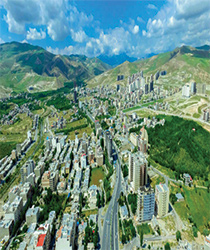Urmia
A large and historical city, that it has semi-arid climate and its weather becomes hot during the summer and extremely cold during the winter is called Urmia. It is the capital of West Azarbaijan Province and Known as Rezayeh during the Pahlavi era. Orumiyeh is a city surrounded by several mountains and borders Lake Orumiyeh in the east, Turkey in the west, the cities of Mahabad, Naqadeh and Oshnavieh in the south and the city of Salmas in the north. This city has semi-arid climate. It has large fertile plain that yields grains, fruits, tobacco and other crops. The population is mainly Azeri Turkish (over 90%), with Kurdish, Assyrian Christian, and Armenian minorities. The remains of ancient settlements are scattered over the plain, as are traces of the ancient kingdom of Urartu.

History
The time of founding of the city is 2nd millennium BCE. In 1918, most of Orumiyeh's Armenian Christian population leaves the city. Most of the remainders were massacred by Ottoman troops. For long periods, the city belonged to the Ottoman Empire. Christians formed nearly half the population in 1900, but in 1918 many left. Most of the remainder were massacred after the retreat of the Russians from the area. Some survivors were later repatriated by the Iranian government. Orumiyeh is connected by primary roads with Tabriz, 75 miles (120 km) northeast, and with Kermanshah, 250 miles (400 km) southeast.
Excavations at Tepe Hassanlou archeological site southwest of Lake Urmia have found that this area was continuously inhabited from the 6th millennium BC to the 3rd century CE. However, Orumiyeh as a city is believed to have a 3 to 4,000-year history. It is a city where different ethnicities and religions have lived alongside one another in harmony for centuries.
Attractions
This city has numerous historical and natural attractions. Some of the most notable historical sightseeing of the city include an 11th century Jame Mosque, the Qajar era (1785-1925) Sardar Mosque, Naneh Maryam Church or the Church of East Assyria, which was built in the year 32 CE, and the 18th century Sepurghan Church. The city has a museum where over 26 thousand ancient artifacts from the 7th millennium BC to the Qajar era are on display.
The natural attractions include Saholan Cave, which is the country’s second largest water cave, Marmishou Lake, waterfall and Urmia Lake . A UNESCO Biosphere Reserve, it was once valued for the threptic properties of its water but the lake has been rapidly disappearing in recent years.
The Lake
This lake is in northwestern of Iran, which is one of the world’s largest landlocked salt lakes, but it is shrinking. This salt lake is fed by roughly 60 rivers and streams, some permanent and some ephemeral, that also deliver salts. Because the lake lacks an outlet, those salts accumulate in the basin. As the region’s arid climate evaporates the water, the salts crystalize along the shore. The lake is too salty for fish life and serves little economic purpose for surrounding areas. There are several islands in the lake, of which Kabud is the largest.